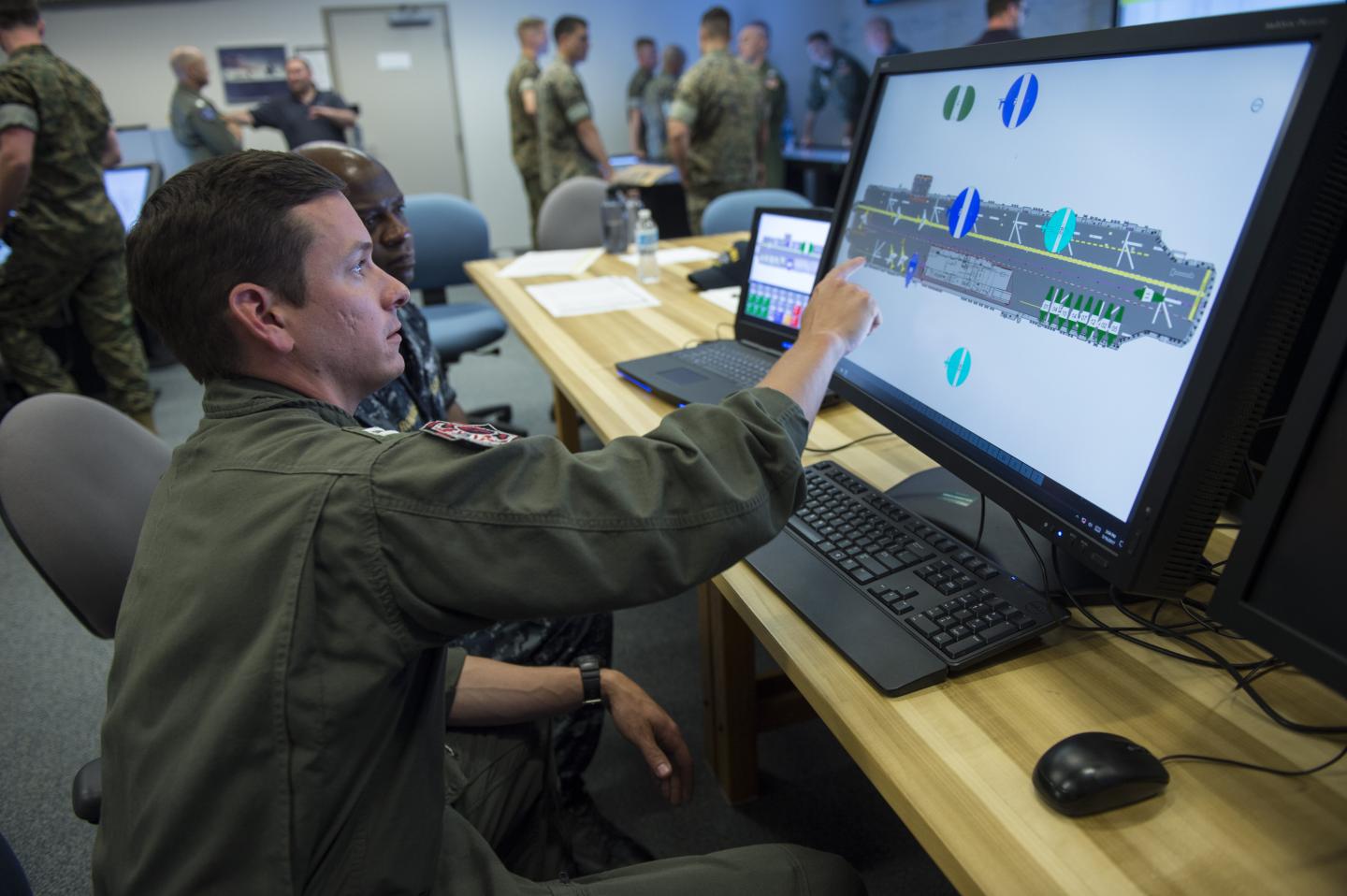
Lt. Timothy Sullivan, assigned to the amphibious assault ship USS Iwo Jima (LHD 7), tries out the Office of Naval Research TechSolutions-sponsored Deployable Ship Integration Multitouch System (DSIMS) located in the Carrier Analysis Lab at Naval Air Warfare Center Aircraft Division Lakehurst during pre-deployment training. Image credit: US Navy photo by John F. Williams
The flight decks of aviation-capable vessels like aircraft carriers bustle with noise and danger–screaming jets, snapping steel cables and powerful tractors and forklifts. Planning and orchestrating this high-octane dance requires precision and accuracy from those responsible for directing deck traffic.
To make the jobs of aircraft handlers easier, the Office of Naval Research’s (ONR) TechSolutions program has sponsored the development of the Deployable Ship Integration Multitouch System–DSIMS, for short.
DSIMS is a mobile software package that features a digital, touchscreen image of a ship’s flight deck or hangar bay, and can be used on a laptop or desktop computer. It enables aircraft handlers to change flight deck configurations anywhere on the ship, plan operations before deployment, and share information digitally with other DSIMS users for improved collaboration.
“This interactive, computerized system is a leap forward for naval aviation,” said ONR Command Master Chief Matt Matteson. “It’s a fairly straightforward technological solution that brings with it tremendous functionality and saves time.”
To track the movements of aircraft and equipment on the flight deck, handlers currently use a tool informally called a “Ouija board”–a waist-high, six-feet-long physical replica of the deck. Located in the ship’s flight deck control center, the board is covered with toy-like plastic models of aircraft, each marked with colored thumbtacks to designate maintenance, fuel or flight status.
The Ouija board’s design has barely changed since World War II. Despite its effectiveness, however, it does have limitations. For example, if aircraft handlers need to plan for upcoming or unexpected scenarios–bad weather or a surprise VIP visit–they must do so while underway, and change the Ouija board back to its original layout after completing the planning session.
By contrast, DSIMS can help plan such situations months before a ship leaves port. When playing out various flight deck situations–called “evolutions”–on the DSIMS touchscreen, participants can use their fingertips or a computer mouse to move around digital aircraft, to show which aircraft need to be in which location and where crates and other equipment should be positioned.
There also are special screen modules denoting aircraft fueling needs, maintenance requests and availability for flight. Each evolution can be saved and recalled during operations, or used for briefings and training.
“DSIMS allows for planning of future evolutions,” said Tim Zieser, an engineer at Naval Air Warfare Center Aircraft Division, Lakehurst, New Jersey. “It also enables aircraft handling officers to create briefs that can be used to inform the chain of command, and train their people before a complex evolution, so everyone is on the same page.”
Zieser recently demonstrated DSIMS at Lakehurst’s Carrier Analysis Lab for Sailors and Marines from the USS Iwo Jima (LHD-7), before the amphibious assault ship deployed.
“The technology is fantastic,” said Lt. Timothy Sullivan, stationed aboard the Iwo Jima. “It lets us make time-critical decisions today, so we don’t have to months from now, over the Ouija board on the ship. It will save us man hours down the road as we execute the mission.”
DSIMS originated in 2016, when a request from Commander, Naval Air Forces, was sent to ONR’s TechSolutions program for a digital, mobile version of the Ouija board. TechSolutions is ONR’s rapid-response science and technology program that develops prototype technologies to address problems voiced by Sailors and Marines, usually within 12-18 months.
Later this year, TechSolutions will deliver a prototype DSIMS for testing and evaluation on several ships, including the Iwo Jima. Zieser and his team hope to see the system issued throughout the fleet next year.
Watch a video of the DSIMS demonstration.
Filed Under: Aerospace + defense




